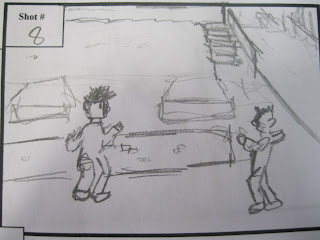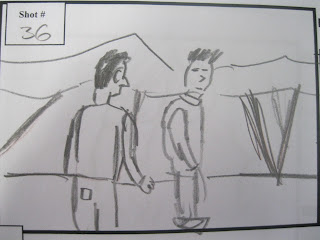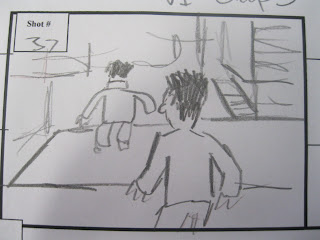 Shot 1
Shot 1In our first shot, we wanted to have a low shot on the ground. A couple of seconds later, we see our main characters foot in the shot. This creates a tensed atmosphere, we wanted our audience to be part of the action as this shot helps to create that thrilling experience.
 Shot 2
Shot 2In this shot, We had the camera on the brick pavement to catch our characters jump over a wall. Our aim is to keep up with the action and we achieved this by putting our camera as close as possible to the action, to keep our audience entertained.
 Shot 3
Shot 3We wanted to have a range of different shots. In this shot we wanted to have a view of our two characters. We also wanted to show our setting in this shot and we also wanted to have a good view of our two characters.
 Shot 4
Shot 4This shot is very similiar to our 3rd shot, but the difference is that this shot is closer. As we aim to keep in touch with the action. As we dont want our audience to get bored and be kept thrilled and entertained.
 Shot 5
Shot 5We also wanted to have an aerial shot for our audience to see a bigger picture of our characters running and the setting they are in. Our aim in this shot is to show our location of our film and we achived this by putting our camera on one of the towers.
 Shot 6
Shot 6In this shot we wanted to get a picture of our main character. We wanted our audience to get a big picture of our main character, so they can get a chance to see clear view of our main character. Because our scenes are fast paced, we wanted to get a clear image of our character.
 Shot 7
Shot 7Similiary with shot 6, we also wanted to get a clear shot of our other character. As our opening is fast paced, we wanted to slow it down a bit and show our audience the second character in our opening scenes.
 Shot 8
Shot 8After we showed our audience clear images of our two character, we go back to the fast paced action. In this shot we wanted to show the obstacles that our characters have to go through, to give tell our audience that our chase scene is thrilling and exiting.
 Shot 9
Shot 9in this shot we see our main character struggle a bit as he attempts to climb a hill. We wanted to create a sense of realism in our project to show that our main character also struggles through the obstacles aswell as achieving to overcome them.
 Shot 10
Shot 10In this shot we wanted to show the audience the next obstacle that our characters will face. In this shot we both aim to show our two characters and the setting. With this long shot we achieve this by giving the audience a clear picture of the shot.
 Shot 11
Shot 11In this we wanted to put the camera at the bottom of the of the wall, for our audience to see the drop. Our aim for this is to make the audience think that is our main character going to jump the wall or not. This makes our audience entertained and thrilled.
 Shot 12
Shot 12Similarly to the previous shot, Our aim for this is to make the audience have questions on their minds and make them want to watch more. This helps us to keep them entertained and electrified.
 Shot 13
Shot 13Like the audience, we wanted to have our other confused. We also wanted to get a shot clear shot of him to make the audience think that he is wondering what would happen next, leaving questions to his mind.
 Shot 14
Shot 14After with all of the questions, we get an answer we would have expected. We head back into the action by our main character taking off his coat and tieing it into his waist and he climbs onto the wall.
 Shot 15
Shot 15We wanted to get a shot of the wall at the bottom. This is for our audience to see how high and tall the wall is. With this shot we aim to blow away the audience's minds and accelerated and not to make them bored.
 Shot 16
Shot 16We also have a shot of our other character looking shocked and confused of how did our main character managed to jump off the big wall. With this shot we also wanted our audience to have a bit of a laugh with our other character looking confused.
 Shot 17
Shot 17In this shot we see our main character land on the grass. This time, the camera is at the top of the wall, for our audience to see how far down he jumped for entertainment purposes. At thisd point our audience get to see how daring our main character is.
 Shot 18
Shot 18Similarly with this shot, we wanted to have a little bit of comedy with having a close up on our main character's face looking back at the camera with a grin. At this point our audience is getting to know our character a little better as he is a bit cheecky.
 Shot 19
Shot 19In this shot we see our other charcter running down the stairs to catch up with our main character. We used a long shot to see the character and the background for the audience to see where he is and where hes going.
 Shot 20
Shot 20We use a low shot to get a shot of our character's shoes as he lands from jumping off the stairs. This creates a sense of thrill and helps the audience feel they are part of the action and kept inspired.
 Shot 21
Shot 21Now we see a third mysterious character with the audience having no clue of who this character is, he seems to be in the chase aswell. This helps our audience kept thrilled and want to watch and find out more.
 Shot 22
Shot 22Now we see a point-of view shot of the new character's point of view. He wonders where our main character has dissaperead too, while the other points out and shows him where he has gone off to.
 Shot 23
Shot 23Now we see our main character and where he's going. We used a long shot on this one for our audience to see where he's off too next. This helps our audience get an idea of where our next shots and scenes would be.
 Shot 24
Shot 24Now we see our two other characters running down the street catching up to our main character. This shot was a bit shaky as we want our audience to be apart of the action and at the same time it can knock their socks off.
 Shot 25
Shot 25Now are camera heads back to our main character, as he runs into a dead end. This helps to create suspense and questions to the audience's minds as they wonder where would he go next and why.
 Shot 26
Shot 26Our character looks for an alternative way to escape as he tries to escape into the corner but as he tries, our other character steps in the way. In this shot we get a shot of his shoes to create tense and to be kept action-packed.
 Shot 27
Shot 27Now he finds a way to escape but first he takes off his tie and unbuttons his top button. This helps our audience to underdstand and know our character more. We also used a long shot to see where hes gonna go next.
 Shot 28
Shot 28Our camera is at the bottom to catch him jumping off the wall. This shot looks like his about to land in the camera which helps us to keep our aim to keep the audience thrilled and entertained. We also get a shot of our two other character looking at him as he jumps off.
 Shot 29
Shot 29In this shot we get to see our main character escaping by jumping onto a building with our two other character's point of view. This tells the audience that they are just shocked that our main character are capable of those things.
 Shot 30
Shot 30But as the audience looses hope, our two other characters gets right back into the action by one of them jumpiung off the wall and start to catch with him again and with the other character to find a more easy and an alternative way.
 Shot 31
Shot 31In this shot we see our other character trying to climb this building where our main character has climbed onto. This keeps our audience thrilled and think that would he catch up to our main character.
 Shot 32
Shot 32As the other character finds an alternative way, we get a shot of him running down a stairs to find a more easy way of catching up with our main character. This also has a bit of comedy and helps our audience to know that our other character is not up for it.
 Shot 33
Shot 33In contrast our other character is fit and desperate to catch up with the main character as he reaches the top of the building with our main character standing there and waiting for his arrival.
 Shot 34
Shot 34We start to slow down again as our two character meet up at the top. This helps our audience to know that there is a little rivalry between the two characters and this also helps to answer a few little questions in the audience's minds.
 Shot 35
Shot 35In this shot we see our other character run down the streets as he looks for a shortcut to get to the other side and catch up with our two other characters.
 Shot 36
Shot 36We start to get back into our fast-paced action scene where we see both of our characters who are on the building start to run again and jump off the building to get to the bottom. This starts to build suspense again.
 Shot 37
Shot 37Now we see them both jump off the building as it gets back into the chase. This keeps our audience thrilled and want to watch more.
 Shot 38
Shot 38We see our main character attempts to escape by jumping off the roof and try to find an alternative way to get down to the streets.
 Shot 39
Shot 39We get to see a point of view shot of our other character from the roof as he stands there watching our main character escapes. This helps our audience to see the things our main character needed to face as he jumps off the roof and run into the streets.
 Shot 40
Shot 40Now we get a long shot of the character who was on the roof. We wanted to have a long shot because we wanted our audience to see where the setting is and to give them an idea of how high the building was.
 Shot 41
Shot 41We get a shot of the main character's shoes to create a thrilling experience for our audience as he runs down towards the camera, this helps our audience to be kept thrilled.
 Shot 42
Shot 42In our final shot we see our main character run down into the streets and blurs into the background and disappears. This puts questions into our audience's minds and makes them want to watch more of our film.
No comments:
Post a Comment